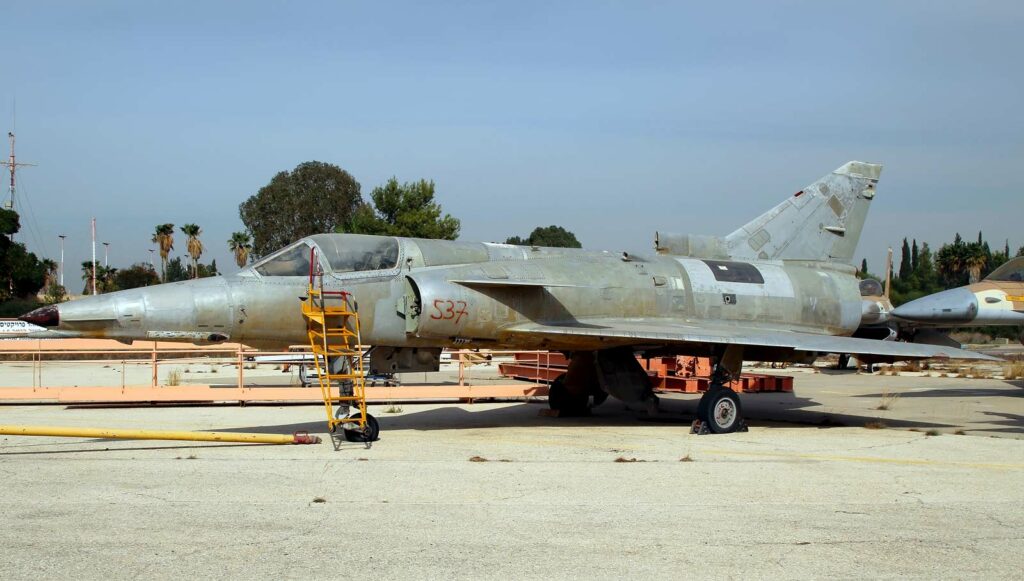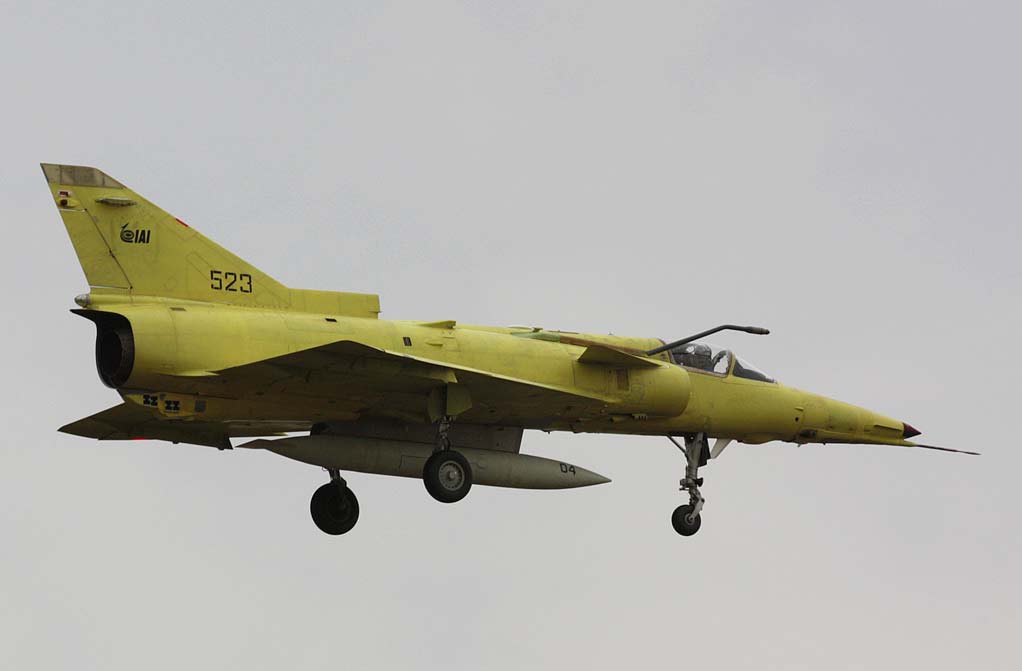IAI Kfir: Israeli-made multirole fighter jet, equipped with a GE J79 engine.
In brief
The IAI Kfir is a multirole combat aircraft developed by Israel Aerospace Industries (IAI) based on French Dassault Mirage 5 technology but significantly enhanced with an American-made General Electric J79 jet engine. This configuration provides a maximum speed of over Mach 2.0. With a maximum takeoff weight of approximately 16,000 kg, the Kfir features an array of avionics upgrades and reinforced airframes to support various weapons systems. Originally designed for air superiority missions, the Kfir has been adapted over its service life to perform ground attack, reconnaissance, and maritime strike roles. Notable for its versatility and robustness, the Kfir remains in limited service, showcasing significant combat history from Middle Eastern conflicts.

History of the Development of the IAI Kfir (Lion Cub)
The IAI Kfir, whose name means “Lion Cub” in Hebrew, emerged in a period marked by rapid technological advancements in military aviation and increasing geopolitical tensions in the Middle East. Following the French embargo on arms to Israel in 1967, Israel was compelled to develop its indigenous military aviation capabilities. The project to create the Kfir began in the late 1960s as a response to Israel’s urgent need for maintaining a qualitative edge in air combat capabilities amid growing regional hostilities.
Israel Aerospace Industries (IAI) launched the development of the Kfir under the initial designation of Ra’am A (“Thunder A”) in the early 1970s. It was based on the acquired Mirage 5 airframe but was extensively modified to incorporate the more powerful American General Electric J79 jet engine, which was also used in the American F-4 Phantom. The choice of this engine significantly enhanced the aircraft’s thrust and speed capabilities.
The first flight of the Kfir took place on October 19, 1973, quickly transitioning the aircraft into production in light of the ongoing Yom Kippur War. Although it did not participate in this conflict, the Kfir was soon introduced into service with the Israeli Air Force (IAF) in 1975, intended to secure air superiority through advanced aerial combat capabilities.
Design of the IAI Kfir (Lion Cub)
The design of the Kfir reflects a blend of proven airframe engineering with advanced jet propulsion. The aircraft integrates a delta wing configuration inherited from the Mirage 5 but includes several structural and aerodynamic modifications. These adaptations were necessary to accommodate the new engine’s greater thrust and the aircraft’s expanded combat role, which now included multirole operations.
Measuring approximately 15.65 meters in length with a wingspan of 8.22 meters, the Kfir’s airframe supports a maximum takeoff weight of around 16,000 kg. The aircraft is equipped with a single General Electric J79-J1E engine, capable of producing a thrust of 18,750 pounds-force with afterburner, propelling the Kfir to speeds exceeding Mach 2.0.
The Kfir’s avionics suite was initially modest but underwent significant upgrades in later variants, incorporating modern radar, navigation, and electronic warfare systems to enhance its operational effectiveness. The aircraft’s reinforced landing gear and robust construction allow it to operate from austere airfields, a vital feature for tactical operations. Despite its strengths, the Kfir’s range and payload limitations compared to contemporary fighters like the F-16 posed challenges in its operational flexibility.
Performance of the IAI Kfir (Lion Cub)
Performance-wise, the Kfir excels in high-speed interception and close air combat roles. With a top speed of over Mach 2.0, a combat radius of approximately 768 km, and a service ceiling of 17,680 meters, the Kfir can engage enemy aircraft and ground targets effectively. It is equipped to carry a diverse array of armaments, including air-to-air missiles, air-to-ground munitions, and an internal cannon for close engagement.
Comparatively, the Kfir holds its own against regional adversaries’ aircraft from the same era but is generally outperformed by more modern aircraft in terms of avionics, agility, and fuel efficiency. For instance, its engine provides significant thrust but lacks the fuel efficiency and operational range of newer turbofan engines found in aircraft like the F-16.
Variants of the IAI Kfir (Lion Cub)
The Kfir program spawned several variants, adapting to evolving combat requirements and export potentials. The initial production model, Kfir C1, primarily served in air-to-air roles. The Kfir C2 introduced improved aerodynamics and enhanced avionics for greater multirole capability. The C7 variant further upgraded engine power and avionics, extending its service life and expanding its ground-attack capabilities.

Military Use and Combat of the IAI Kfir (Lion Cub)
In military service, the Kfir was first engaged by the Israeli Air Force during the late 1970s and 1980s, participating in numerous aerial combats and ground-attack missions. It proved effective in striking against surface targets and in air superiority missions over Lebanon. Its robust design enabled effective operations in the hostile and varied terrain of the Middle East.
The Kfir has been exported and used by countries such as Colombia, Ecuador, and Sri Lanka, serving in roles ranging from conventional warfare to counter-insurgency operations. The aircraft has participated in various conflicts, adapting to different combat environments and showcasing its capabilities in both air-to-air and air-to-ground scenarios.
Despite its age, the Kfir remains in limited use, primarily for adversary training in the United States under civilian contracts, where its performance characteristics provide realistic combat training for U.S. military pilots.
The IAI Kfir has been a significant asset in the arsenals of countries needing a robust, versatile fighter aircraft capable of performing a wide range of military duties. Its development and operational history reflect the challenges and requirements of modern aerial warfare, standing as a testament to the ingenuity and adaptability of its designers and operators in maximizing its combat potential over decades of service.
Back to the Fighter Jet section.